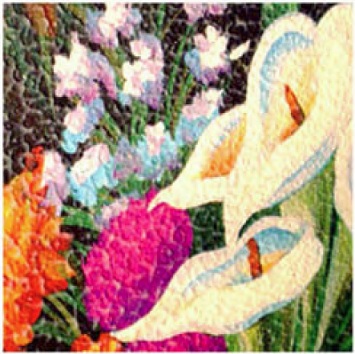Well, it happened again today...
A family brought in a load of artwork they had been holding onto and storing for years, confident the pieces were worth keeping because they "just had" to be of some value. After hours at the computer and a multitude of fruitless searches online, the family called us and made a verbal consultation appointment with our certified appraiser. They had several pieces collected over the years from estate sales, garage sales and antique stores for our appraiser to inspect.
There were a few original paintings from the 1950's and the rest were offset lithographs. The long and short of the consult- on a good day...if they could resell them for $40 apiece they should take it and run. Several of the pieces had more value in the frame than the work itself. Ultimately these are what we put into the 'Decorative Only' category. They are made in mass quantities to hang on the wall and look nice over the couch, maybe match the rug.
One piece in particular had pushed the couple to seek the professional insight of our appraiser. "We found this exact one on the internet going for $13,000-$14,000. It has the same markings and everything." The piece was an offset lithograph, a photomechanical reproduction of an original print. "But it has the same wording on the bottom, same exact title." As with all good reproductions they are made to duplicate the original in every detail, which includes every mark on the piece; even the exact title.
Several months ago we had a client call and ask if our appraiser was qualified to handle French 18th century drawings. I told him she was an expert in European and American art and would be capable of appraising his piece. He then asked to speak to the appraiser himself, not convinced by her accreditations, résumé or 26 years as an appraiser. For fifteen minutes he grilled the appraiser, shooting question after question to ensure his work would be in good and competent hands. Turns out the client had done extensive research on his own...go figure. He had done six weeks of research, the vast majority of it online, literally - he spent over a month and a half browsing the internet to find answers on what he had. After all that time, after looking at images in books, and photocopies of the images in the books and photographs of the photocopies of the images in the books, he had convinced himself beyond any reasonable doubt that he had an original French 18th century drawing by Jean-Honoré Fragonard. So, after interrogating our appraiser, he finally decided to make a verbal consultation appointment so a professional could confirm the truth of his "discovery."
It took our appraiser less than ten seconds to tell him he had a lithograph.
How he convinced himself of what a drawing versus a lithograph looked liked from a series of reproduced images was the "mystery" he never grasped. He had wasted a tremendous amount of time and energy doing research, and in the process had built up an excitement that was dashed by the truth of what he actually had; a print.
The moral of these two stories, you must know the medium. The medium. The medium. It starts with the medium.
Commonplace phrases we hear from clients go like this:
"I know it's old, it's been hanging in my Grandma's house for years" "Its got to be expensive, it's sooo old." "Must be valuable, it is an original." "But it's signed..." "Do you guys know who Insert random artist is?" "It has a beautiful gold frame, I just know its worth something."
The breakdown of these is: age ≠ value, a signature ≠ value, originality ≠ value and something being on canvas ≠ a painting, a piece on paper ≠ a print, and a gold frame does not mean its from a castle in the 17th century; seriously, if one more person tells me their piece has a gold frame...
Age ≠ value Just because something is old does not mean it is valuable. Sure the possibility is there, but age is not a guarantee of value. A client called last week and explained a painting in extreme detail, over the phone and said, "I bought it in 1985 for $1,500, so what would it be worth now?" Its worth depends on a multitude of factors; medium, condition, size, subject matter and the ever important artist. Works of art are not certificates of deposit slowly appreciating over time. And something isn't necessarily old just because the painting was hanging in Gammie Baba's house for as long as you can remember. Odds are Gammie Baba was born in the 20th century.
A signature ≠ value The signature is very important. A beautiful unsigned still life painting might be valued at a few hundred dollars, but if it bears the name Renoir or Cezanne and can be legitimately attributed to one of those artists, the value drastically changes. When doing an appraisal we look at many factors—medium, size, condition and date. But among all the qualities which contribute to the value of a piece, attribution to a well-known artist is the most important factor. However, not all signatures add value to a piece of art. Some signatures are so illegible as to defy identification even after great amounts of research. Some, dare I say the majority, are quite legible but do not trace back to a known artist. Almost every family can point to a grandmother, aunt or uncle who took some art classes and produced dozens of pieces, each lovingly and prominently signed. Though you love the paintings Gammie Baba painted for you when she took up art class, they fall under the 'Decorative' category; unless, of course, your grandmother was Grandma Moses...but that's another story.
Originality ≠ value Again, thinking back to your Gammie Baba's paintings and other works done by weekend-art-warriors, just because something is an original, the one and only authentic work or an original print, does not necessarily connotate value. There is a huge market for original works, whether to be sold to tourists as souvenirs or as something nice to hang above the fireplace and bring the room together. Again, among all the qualities that contribute to the value of a piece, attribution to a well-known artist is the most important factor.
Canvas ≠ painting : Paper ≠ print This is a common issue that fools new collectors or clients who have recently inherited or run into pieces about which they know very little. They see canvas weave on their artwork and instantly think it is a real painting. It has to be, right? It is on canvas after all. The truth is, canvas does not equal a painting. It could be a gicleé, a print from a large-format, high-resolution digital image printed directly onto canvas. The word gicleé actually comes from the French word gicleur which means nozzle. Since the resolution is quite high on these prints, it can make them difficult for a novice to spot. Currently, gicleé printing is being used by most publishers of decor art for office environments. It is also being used by some photographers and by computer graphics artists to print their work. A gicleé can be printed onto canvas, all types of papers, woods, metals, glass...whatever the client wants. These prints can be printed on demand, meaning they do not have to be released in editions. If you suspect gicleé printmaking, you need to have a good print appraiser take a look.
It could also be a print-transfer-to-canvas. Prior to the introduction of gicleé printing in the mid-1990's, manufacturers of decor items might take an offset lithograph and glue it to canvas in order to simulate the look of a painting. These products were often covered-over with a swirly clear acrylic coating in an attempt to simulate an artist's brushstrokes. These are just two of the types of items which might at first appear to be original paintings but are in reality mass-produced decor items.
Gold frame ≠ value I PROMISE.
This all boils down to clients and art enthusiasts not knowing the whatof what they have. The internet is thought to have all the information ready and available; just go to that search bar and you're set. In ten, maybe twenty minutes, you will be an expert, right? Right?
Wrong.
Expertise in the art world is built upon years of training and experience. A good appraiser has many years of book-knowledge about their given field along with many more years of handling and looking at actual artworks and time spent doing research.
The family I mentioned at the beginning of the post asked the appraiser why the two originals they had were not worth more than $40. Our appraiser, who had not lifted the works up from the examination table, said, "Well they are 1950's oil on silk tourist works from Japan, probably brought back with a soldier from duty after WWII. They are nice and decorative, they serve their purpose as art, but don't have a secondary market." The client's eyes widened in surprise, then she asked, "How did you know it was from 1950?" as she picked up the work and showed the hand-written inscription, 'Japan, 1951' on the back. Our appraiser explained that in the 26 years of professional appraising, she's seen hundreds of similar items. To a novice, it was a very nice original oil on silk from the 50's. To the eye of our trained and seasoned professional, it was another Japanese tourist painting.
The lessons to be learned here...If you do not know the what of what you have and you turn to the world-wide-web for answers, your online searching will be an effort it futility, a huge waste of time.
So, by all means get out there. Collect art. Go to estate sales, garage sales and auctions. Find what you like and have fun. Build your connoisseurship as you go. Look at art. Ask a professional to teach you what to look for. Art-world terminology can be confusing. Sometimes that is just because of the nuances of language, and other times unscrupulous dealers use opaque, misleading and untrue descriptions to defraud the buying public.
When you need the services of a good appraiser, either for a written appraisal or a verbal consultation, remember that the money you pay for an objective well-trained appraiser to tell you the truth about your artworks is money well spent. Not all knowledge is free or available on the web.
-M.P. Callender
Signet Art


